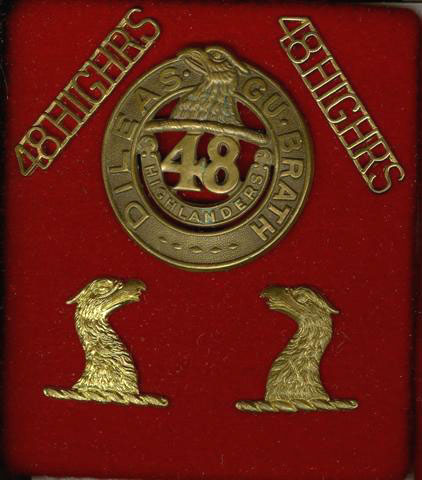
Cap Badge, Shoulder Titles and Collar
Badges of the 48th. Highlanders of Canada
(Credit for photographs of the badges goes to Clifford Weirmeir, with his splendid website about
the Irish
regiment of Canada)


Left: 48th. Piper's Khaki Bonnet badge
mounted on
the special Stewart of Fingask Tartan backing.
Right:
This Davidson tartan was worn by
the drummers.
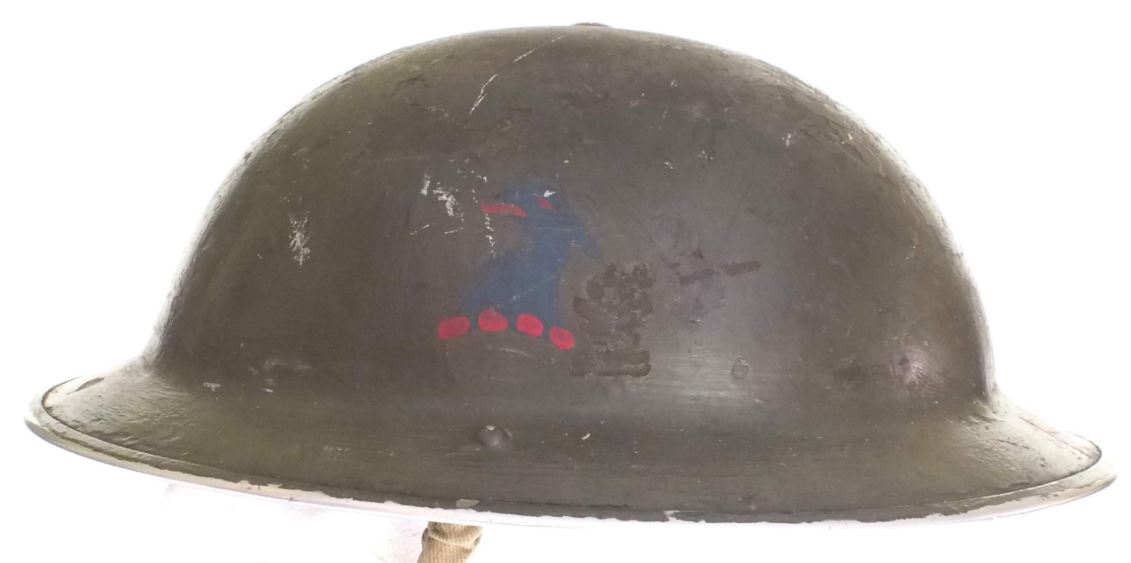
This 48th Highlanders Helmet Flash was worn on the
left side of the MK II Helmet
Source: www.warrelics.eu

This type of Horsehair Sporran was worn by the 48th.
Highlanders' Pipe Band.
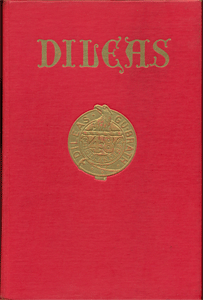
The Regimental History of the
48th. Highlanders of Canada.
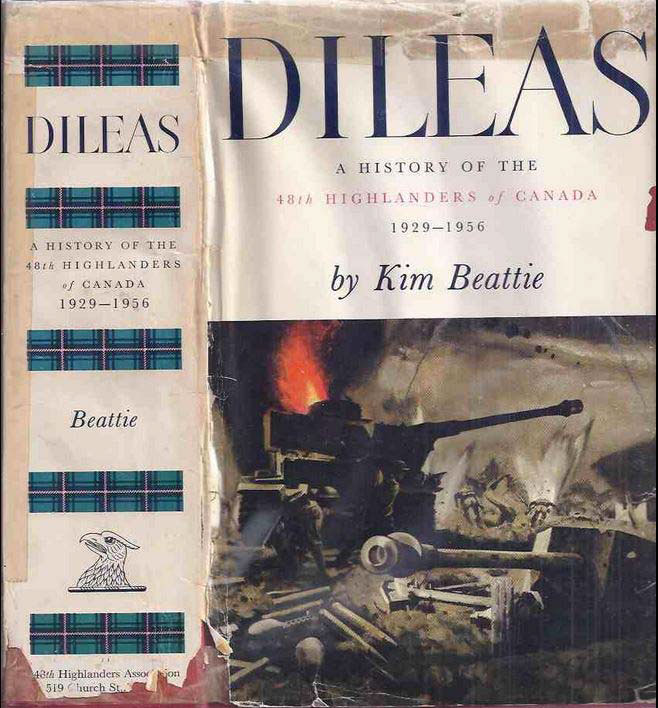
The Paper Dustcover of Dileas
N.B,: The following texts on this page
are not intended to narrate the full battle history of the 48th.
Highlanders as a fighting Regiment, but exclusively to give some
more background information on the photographs which we still have
of the wartime Pipe Band of the 48th. Highlanders of Canada, plus
some interesting quotes about the pipe band as was described in our
correspondence with 48th. veterans and found in their Regimental
History, "DILEAS" (shown above here), which was given to us as a
present for this purpose, when we visited them in Toronto, 1989.

Pipe major Andy Anderson,
48th. Highlanders of Canada 1939-1945
"In December 1939 the Part II Orders came through, whereby Sjt. A.
Anderson, who pre-war already had anciennity as a sergeant in the
48th. Highlanders of Canada, was appointed as Pipe Major (Senior N.C.O.) in charge of
the Pipe Band at BATTALION HEADQUARTERS."

Then the move
to Great britain took place.
"It was on
December 16th, Lt.-Colonel Haldenby left for Halifax with the
Battalion under definite orders to entrain next day." December 17th
saw the 48th Highlanders, under Major Bill Southam, clambering
aboard two railway sections on C.N.E. sidings, surrounded by a
multitude of friends and relatives, who had attended an impromptu
reception by the Highlanders throughout the afternoon."
"The streets were sheathed in ice, and for exercise a march was laid
on, led by the pipers. They skated and slid rather than marched, and
the Battalion had a great belly-laugh when a piper went down, his
pipes squawling like a startled and dying banshee until the wind
went out of the bag."
"Halifax was
its familiar, bleak wartime self. From their train windows, its
wintry streets offered no inducement to linger, and they went
straight aboard His Majesty's Troopship E9 - formerly the Reina del
Pacifico, Capt. Ridyard, Master. No speeches, no cheers, no tears
accompanied their secret departure. But their own pipers lifted
their clattering steel-shod boots down the metal ramps of the
shipping sheds, and up the gangplanks. They were playing Hielan'
Laddie, their regimental march which, some remembered, had lifted
their victory-step over the Rhine on the Cologne Bridge in late
1918. On that occasion Hielan' Laddie was marking the triumphant
conclusion of the 1st German War for the 48th Highlanders. Now it
was marking the departure of vibrant young Canada, garbed as a new
battalion of 48th Highlanders, on the way to face the same grim and
prepared enemy for a second time."
"As the 48th
Highlanders surged up the gangways of the Reina del Pacifico, with
Colonel Haldenby looking worried, and Capt. Johnston and Lt. McLaren
also on hand to see them aboard, they were so filled with
anticipation that the pre-game tension was lightly on them which
they would some day call before-battle nerves. It was to evaporate
almost at once in an historic foul-up in troopship loading. Within
minutes, they were being crammed into every nook and cranny of the
converted Chilean liner, with entire platoons ordered into spaces
which would have been tight fits for sections. Space-per-man seems
to have been allotted on a base of standing, not sleeping or living
room, which may give an idea of the overcrowding and general snafu."

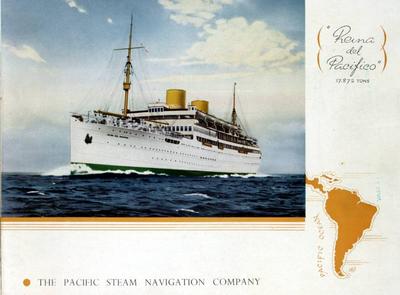
Two postcards of the troopship "Reina del
Pacifico"
From
http://www.oceanlinermuseum.co.uk/Reina%20del%20Pacifico.html:
R.M.M.V. Reina
del Pacifico
RMMV Reina del Pacifico was a
17,702 GRT passenger ship operated by the Pacific Steam Navigation
Company. Built by Harland & Wolff at Belfast, she was launched on 23
September 1930, and was the largest and fastest motor liner of her
time, sailing from Liverpool to the Caribbean, Panama Canal and
South America.
She became famous in 1937 after the former British Labour Prime
Minister, Ramsay MacDonald died aboard whilst on a cruise at the age
of 71, just two years after leaving government.
During the Second World War she was requisitioned for service as a
troopship, and also took part in the landings in North Africa,
Sicily and Normandy.

"When the
Reina del Pacifico anchored in Bedford Basin, she joined her sister
ships of the 1st. Division's convoy, the SS Andes,
Ormond, Almazora and Orama, and the seized Polish transports, Batory
and Chrobry.
As the Highlanders gradually made the acquaintance of their
shipboard companions, men of the 57th Field Battery from Quebec
City, the 90th (anti-tank) Battery from Fredericton, the 2nd Field
Park, C.E., from Toronto, and the 4th Field Ambulance from Fort
William, they discovered the Reina del Pacifico was full of
surprises, few of them pleasant. The troopship was ballasted by bags
marked `South American flour', which is harmless stuff, but Capt.
Ridyard went below to inspect it daily. He blandly assured the 48th
Highlanders that flour was the perfect ballast: "If it becomes wet,
it turns to dough and seals all leaks." The landlubbers only vaguely
suspected their legs were being pulled by the Merchant Marine."

Andy Anderson, as wartime
appointed Pipe Major, leads the Pipe Band on board the troopship
"Reina del Pacifico". Archie Dewar, who would replace him as Pipe
Major in 1945, walks next to him
"When the Troopship Reina del Pacifico
[see below for more details on this ship] left from Bedford Basin
(see above) on
the way to the Clyde (Scotland), There was none to watch them leave,
but on the upper decks their pipers played them on their way with
challenging pibrochs and marches. As they crossed the submarine
boom, the Campbells are Coming seemed fitting; then it was The Road
to the Isles, and they were reminded by stern-faced Scots that this
air was purely military. (It was once titled The Burning Sands of
Egypt.) Their troopship (the Reina del
Pacifico) said farewell to Bedford with Hielan' Laddie
skirling from the deck."

"The martial piping made the start of their voyage gay, proud and
impressive. The young Highlanders were stirred; the pride of
fighting men, or at least of a renowned fighting regiment was
suddenly - and secretly - running through them."
"GREAT
plans were made for the 48th Highlanders to celebrate Christmas Day
in mid-Atlantic, with anticipation including Prayer by the seasick
that they could at least show up for the Christmas dinner. There was
a fine concert, with the 48th pipers and the two pianos providing
the music, and entertainers from several units participating."
"The
Highlanders had enjoyed Capt. Ridyard, master of the Reina del
Pacifico and he seemed to enjoy convoying Canadians; there had been
much laughter at the Captain's table. As they went past John Brown's
shipyard, and saw that the sand-bagged Queen Elizabeth was nearly
ready to be slipped off the ways and taken to New York for
completion, Capt. Ridyard had a last hearty laugh. He felt good; his
ship was Glasgow-built, so she had come home. "You know that ballast
down below?" he asked a group of 48th officers, who were intently
interested just then in the greetings from the close-up shore,
including cheers, and also stiff salutes from British officers. He
caught the group's sharp attention.
"It's dynamite !" he told them, and rocked in silent mirth. The 48th
Highlanders were fervently glad they were now passing gently up the
narrow Clyde, as they realized they had crossed the wartime Atlantic
ballasted by explosives disguised as flour. They were enthralled by
the thoughts of heather in the spring on the slopes of the
snow-topped Scottish hills, but they were also remembering Capt.
Ridyard's deadly fear of fire. They wondered how high they would
have been skied if a torpedo had found that dynamite.
It was 10 A.M. on the morning of December 30th, 1939, when the
Highlanders' troopship dropped anchor in the stream off Greenock."
"In the early afternoon, the Reina del Pacifico came at last to a
full stop, and was motionless beside the King George V dock in
Glasgow."
Then the
48th
Highlanders had to be transferred from the discomforts of an
overcrowded troopship to the bitter chill of a troop train that had
been standing for hours in the Glasgow winter, with Aldershot as
destination.
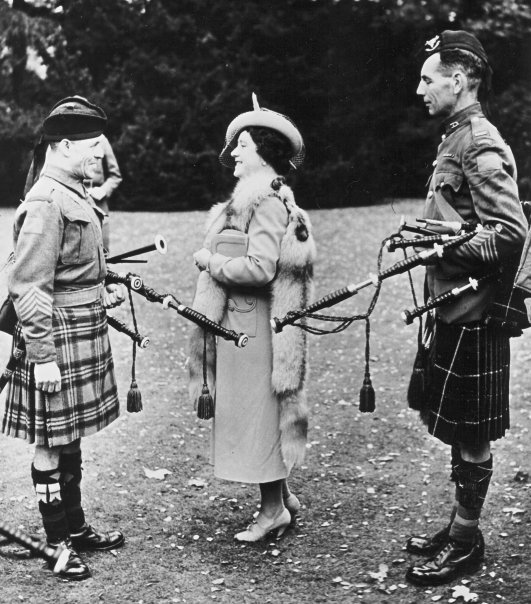
Pipe Major Andrew Anderson meeting the queen at
Aldershot, England, 1940
"Then,
ignoring the hour, and defiantly determined to mark the day and the
occasion, the pipers bravely tried to lift spirits by piping through
the train as it dropped south through England in the dark hours of
the morning. The pipers were playing in the New Year with the proud,
sad songs of Scotland-and sending greetings from the 48th
Highlanders, back for another war, across the fields to the sleeping
English towns.
In a thick, pea-soup fog, their first train section came into
Aldershot station at 8:00 A.M., with the second 20 minutes later.
Stiff-legged and travel-rumpled, they lined up as a Battalion for
the first time on English ground under the eyes of General
McNaughton and Lt.-Gen. C. F. N. Broad, C.B., D.S.O., who was G.O.C.,
Aldershot Command. They were marched off by their pipe band, and the
pipers of the Toronto Scottish, who had been turned out to welcome
them."
"To have known they would still be Aldershot - soldiering in Surrey
and Sussex in 1943 - would have been an appalling thing to face on
that January 1st of 1940."
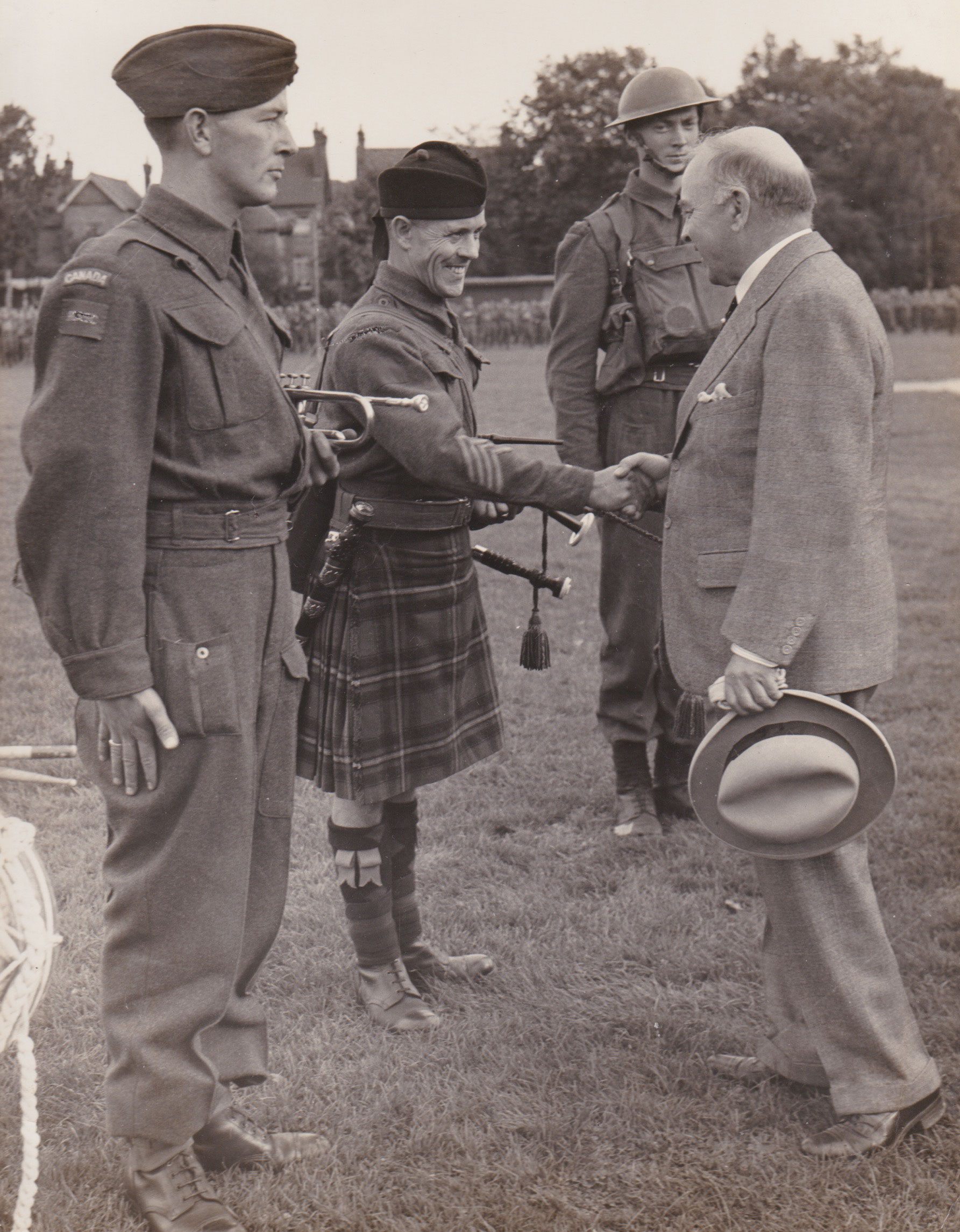
Pipe Major Andrew Anderson proudly shakes hands with
Canadian Prime Minister William Lyon MacKenzie King, September 1942

The photograph below of the
1st Battalion Pipes and Drums was taken in Seaford Sussex (England),
Spring 1943

Front Row:
Morrison, Grant, Pipe Major
A. Anderson, Col Johnston, A. Dewar, Donaldson, Blyth
Middle Row:
Rennie, Mcvey, MacDonald, J. Raffin, Dewar, Stevenson, Boyle, Marr
Back Row:
Cook,
Edminston, B. Elms, Thompson, G. Baker, MacMillan, Seggie, Godfry,
Brodie
"While the 48th. Highlanders of Canada were stationed in Aldershot, Pipe-Sgt. Anderson went to Edinburgh
for a course in piping."
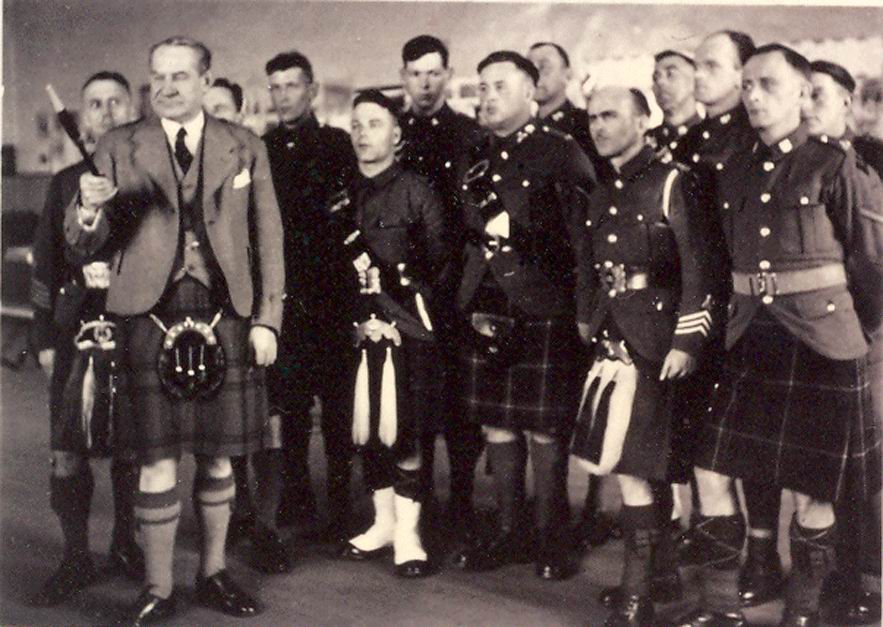
During the Pipe Major's Course, Pipe Major Anderson
(with white spats on) stands next to the famous Willie Ross at
Edinburgh Castle

"After their training period, in June 1943 the 48th. were
prepared for a secret convoy to Sicily.
The warning of
a final move was well-timed; on June 13th, the 48th Highlanders were
ordered to break-camp permanently. They entrained at Old Cumnock for
Gourock, and took up quarters aboard a troopship, anchored in the
Isle of Aran's Brodick Bay. She was H.M. Troopship Derbyshire, Capt.
Mann, master.

H.M.
troopship Derbyshire
DERBYSHIRE was built in
1935 by Fairfield Shipbuilding & Engineering Co. at Glasgow with a
tonnage of 11660grt, a length of 482ft 7in, a beam of 66ft 2in and a
service speed of 15.5 knots. Bibby's last four masted ship she was
launched on 14th June 1935 and commenced her maiden voyage from
Birkenhead to Rangoon via Marseilles and Colombo on 8th November.
When the Second World War broke out she was converted into the Armed
Merchant Cruiser HMS Derbyshire during November 1939. With her main
and mizzen masts removed and her after mast reduced to a stump she
was armed with 6 x 6in, 2 x 3in anti-aircraft and machine guns and
deployed on Western Approaches patrols. She also acted as a convoy
escort and covered over 156,000 miles in under two years. In 1941
she was decommissioned and converted into a troopship flying the red
ensign. During Operation Torch in November 1942 she carried U. S.
troops from Liverpool to Arzew Bay in Algeria and troop
reinforcements to Mers-el-Kebir and Algiers. Later in that year she
was converted into an LSI (Landing Ship Infantry) for the invasion
of Sicily and equipped with 20 assault craft in two tiers under the
davits with one 'leader' on deck. In 1943 she was part of 'Force G'
and landed, at Pechino in two waves, first her commando force
followed by Canadian troops onto the same beaches. On 22nd January
1944 she carried troops to the Anzio beaches and, in the following
August, took part in Operation Anvil, the invasion of Southern
France where she landed U. S. troops at Cap Camarat before returning
to Liverpool to prepare for service in the Far East.

"At 21.47
hours on June 28th., His Majesty's Troopship Derbyshire
shipped her anchor under the unbelieving
eyes of the Highlanders. And then they were off. The pipers were
lifting their hearts and stiffening their already straight backs to
the proud lilt of the Cock o' the North."
"Few noted their going as they slipped down the Clyde to chase the
dropping evening sun; after all, Glasgow
and the old bomb-scarred shipping river had seen so many troopships
go. Besides, their departure was as unheralded as their destination
was a sealed secret, locked in two mysterious black ships' bags, and
those secretly stowed away by Captain Mann. They would be brought
out and opened when they were safely far at sea.
10 July 1943 the 48th. landed on Sicily at Pachino
Beaches"
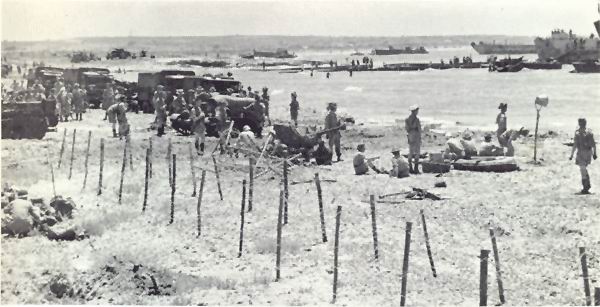
After the landing, Pachino Beaches (10 July 1943, about 10.00 a.m.)

"Having fought their way through Sicily, on September 3rd.
the 48th. had to land again, this time on the toe of
Italy.
With a flourish befitting their refurbished state-and just to
emphasize the dry landings of the first wave-the 48th Highlanders
'of Canada landed on The Toe of Italy during the bright sunny
morning of September 3rd, with their pipers playing that challenging
and even rollicking air The Campbells are Coming! It seemed to fit
both the occasion and the mood of the Highlanders. They had sailed
the Strait cooking and enjoying a meal, vastly interested spectators
of the Messina Regatta. Their landing in Italy was gay, not bloody.
They marched
off their LCIs nearby Reggio, with the pipers off first, and now
rendering The Road to the Isles, to learn all their objectives had
been gifts to the first wave, including the village of Gallino,
which had been named as a 48th objective."
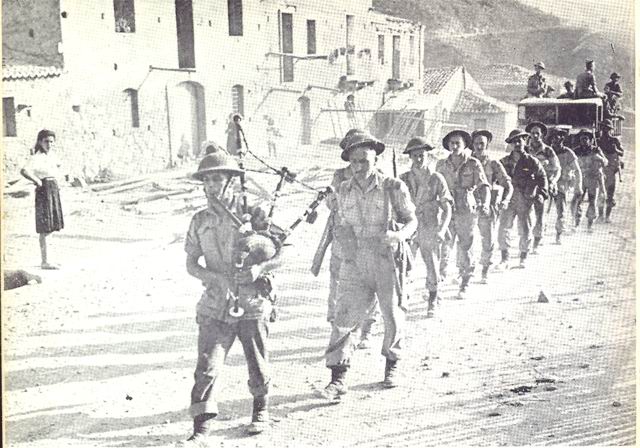
Pipe Major Andy Anderson leads 48th.
Highlanders H.Q. Company on the march at Straorina, Italy 1943

"Capt. Eardley
Wright's Able Company was leading, followed by Battalion H.Q. and
H.Q. Company; Major Ian Wallace's Charlie, Capt. Bob Lyon's Baker
and Capt. Jim Counsell's Dog Company. They were on the axis of the
Division's line of advance, for a reconnaissance in force to the
northeast, into the mountains. (on the way to Straorina)"
During the
fight for Assoro, two members of the pipe band were also killed:
“two company
stretcher-bearers were among the killed popular Big Bill (W. J.)
Thompson, the bass drummer in the pipe
band, and brave Jim Cameron. They had been secure in their slits
when the chilling summons: "Stretcher-bearers!" had come thinly to
them through the tumult. It was the cry for help no stretcher-bearer
ignores. From different slits, well separated, both men had at once
climbed into the open to face the great gouts of flame and the
slashing shrapnel, to give aid. Both died.”
“The last smash of heavy shells had increased their Assoro casualty
list to 8 killed and 29 wounded. Cpl. Harvey Ball and Ptes. Jim
Cameron, Doug Holmes, Ray Leadbeater, Murray Whalen and Drummer Bill
Thompson were dead, and Ptes. Carl Burke and Irving Leith died of
their wounds.”

on October 14th. Campobasso was taken, and the 48th.
spent some time there to recuperate.
"The companies and the R.A.P. now temporarily lost their
stretcher-bearer pipers. The Pipe Band had been briefly concentrated
for Divisional Sports Day at Potenza, and now it was done again, but
more seriously this time. There was a hint they might stop being
stretcher-bearers except in major actions. They went back to
practicing as a band with the enthusiasm which only pipers possess.
("It was awful!" said an unconverted Sassenach. "Just one of those
peculiar Macs practicing on a chanter at daylight-they always chose
daylight -was bad enough. But now they all shrilled and squawked at
once before breakfast, without a bag in what they called their oxter,
and with every chanter at a different pitch. And some of those
Scotsmen pretended they loved itl")
"They were immediately on display. On Sunday, October 17th, the 48th
Pipe Band was heard over the BBC. A church service for the Brigade's
R.C. personnel was held in Campobasso Cathedral, with Brigadier
Graham taking the parade's salute, while the 48th pipers played them
past the review-point. The enemy was still shelling Campobasso
resentfully, and obliged the BBC crew at just the right time by
sending over several reverberating salvoes. So those who heard that
BBC programme had both stirring music and the rolling crash of shell
bursts for martial colour."
"The Highlanders were thankful their band was so remote from home
that it could be heard, but not seen. There was something
incongruous about regimental pipers dressed in worn khaki drill,
washed to a dirty yellow, with the dark tartan ribbons of their
pipes, their sole touch of colour. They did not even have their gay
glengarries. All their colourful and imposing accoutrements were
stored in the trunks left in England."

Click on the the above
photograph to see an enlargement of the Pipe band walking on
parade in Italy, no kilts but khaki drill uniforms.

"Ever since Pachino, the entire Regiment had hoped for the day when
their band could march proudly in front of them once more, with
their kilt swinging, wearing their Stewart of Fingask tartan kilt
and plaid, gleaming buckles, a leopard skin for the big drummer, and
with a jewel-hilted dirk for the Pipe Major and a skean-dhu down the
hose-top of every piper."
"The Pipes could make them proud and sad and pugnacious by turns;
they swore they could put dew in the eye of a Brass Hat. They had
seen it happen to Chris Vokes, who was not of course the cynical
type, and who always wanted to hear Over the Seas to Skye. They had
heard the pipes made Crerar choke-up, and would not be surprised if
they could move even a Simonds."
"They habitually jeered the parable-quoter (recently transferred from
H.Q. Company), but for once agreed when he declared that the pipes
could move the very bladders of such stolid characters as the Plough
jockeys, or even the cynical R.C.Rs.
He quoted Shakespeare's Merchant of Venice to prove this could
happen:
"Some men there are love not a gaping pig; Some that are mad i f
they behold a cat;
And others, when the bagpipe sings i' the nose, Cannot contain their
urine."

"If mere money had been reason the band's accoutrements could not be
replaced, instead of shipping shortage and a thousand things given
greater priority, the men would have collected the cash themselves
from their small daily pay. They hoped for a miracle some day -in
the attitude of the Brass at 1st Echelon. They would have to relent
in the contention that band uniforms were unimportant and could not
be allotted cargo space to Italy; they had scorned all requests.
Then, unexpectedly, the 48th were ordered into Campobasso, to take
up billets. They did not have far to go, as their crossroads was
only 3 miles southeast of the city's outskirts. It was a long time
since the 48th had packed up with the elated expectation of October
20th. The move-up from their different positions on the rugged
Campobasso plain went off like clock-work, and the long files of
48th Highlanders snaked jubilantly across country. They were to
taste billet life for the first time."
The Band played Retreat before hundreds in the square in the
evenings.
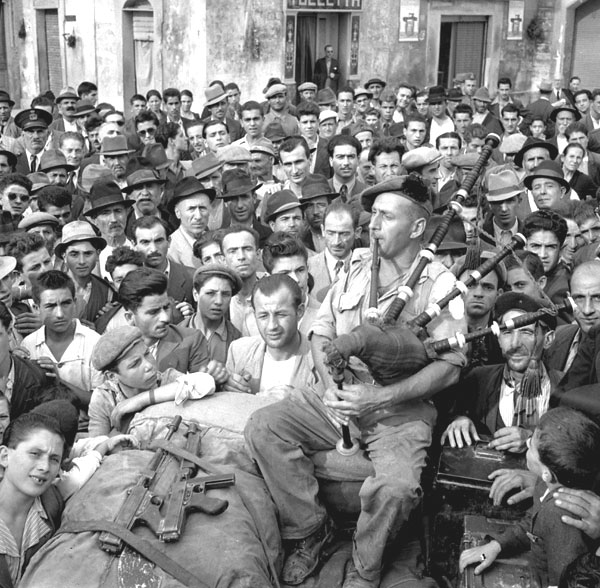
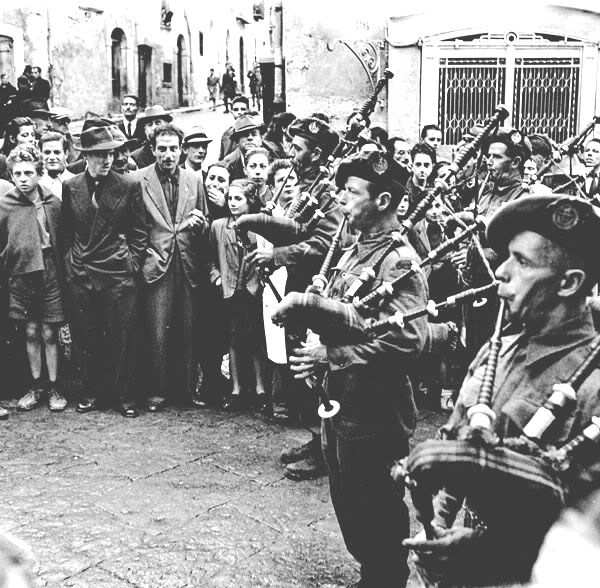
The pipers gave an impromptu concert for the
civilians of Campobasso on 18 october 1943

"Campobasso was rapidly being converted into the first organized
back-line recreation and short-leave centre which the Auxiliary
Services were able to put together for the Canadians in Italy."
Before the Highlanders left, the Auxiliary Services staged a "48th
night" at the Capital Theatre, with a special film, Cash and Carry
for their entertainment. On this last day (22nd), Lt. Doug Cousens,
who had recently joined the Battalion, commanded a formal
guard-changing ceremony with men of Dog Company and the Pipe Band.
It was an excellent show; the square was so jammed with impressed
Campobassoans it was impassable.
When the move-out came "after the theatre", the following looked
infuriatingly pleased because they were remaining behind: the
students attending the Regimental Serjeant-Major's N.C.O. school;
the Q.M. stores (near the station) ; the Pipe Band and the
Transport.
It was at Torella that Pipe Major Andy Anderson and Cpl. Jim
Ironside became the caretakers of 48th cemeteries. The Pipe Major
cared for all 48th graves faithfully to the end of the war,
retracing the Regiment's steps frequently to visit the earlier
cemeteries. Cpl. Ironside fashioned the crosses which were to mark
the Regiment's graves from now to the end. They were of
white-painted wood, bearing a green maple leaf, topped by the Dileas
crest.)"
"Pipe-Major Andy Anderson composed a new pipe march, Colonel
Johnston at Campobasso."

Pipe Major Andrew Anderson plays a memorial service
for fallen soldiers in Rimini, Italy, 1944

BRIGHT PROMISE FOR THE BAND
"Most depleted of the infantry battalions was the 48th Highlanders,
which, in spite of a relatively unspectacular role during most of
the October fighting, had lost 26 killed and 70 wounded - striking
evidence of the exacting nature of the routine infantry task.
The Highlanders enjoyed the forthright talk by the Defence Minister,
a 1914-18 battalion commander. He had the Highlanders close packed
around his jeep after the inspection, and asked them what they
wanted most. He heard two specific requests: "We want our mail," and
"Give us some movies that were made since 1929."
It brought action; the quality of their movies perceptibly improved,
and an air-mail service was shortly carrying their letters between
Italy and home in 5 days.
The VIPs were still in sight going down Torella's long hill when the
entire battalion learned of a thoughtful gesture by General Crerar.
At the close of the parade, he had voluntarily authorized the
immediate procurement of proper equipment and accoutrements for the
48th Pipe Band. He had admired the Band in all the glory of its full
Highland dress in England, and had been shocked to see the pipers in
Torella in drab battle dress, without even glengarries. When he
learned their accoutrements were stored in England, and adamantly
held there by those who allotted shipping, General Crerar told the
Colonel to send him the details personally, with a list of additions
required. The Defence Minister overheard, and applauded the purpose.
The General meant what he said; he gave the matter top priority.
Within a few weeks, the uniforms and colourful regalia arrived in
Italy with precedence over other things. ("Much to the disgust of
the Brass at 1st Echelon who failed to appreciate the importance of
bands to an infantry regiment".)
Since the Band's loss of equipment in the 1940 foray to France, and
because of the restrictions of combined operations, the Pipe Band
had never been large. But it could still boast 10 sets of pipes, a
base and three side drums. Now it was to wear again its tartan kilt
and shawls, silver buckles and badges, and have the martial colour
which means much to a Highland regiment.
The Regiment was not to forget that thoughtful gesture by General
Crerar.
The end of their Torella break-off was near. There had been many
officer changes, and the Highlanders now lost their M.O., Capt. Fred
Skinner, who had served with them for 11 months, which was long
enough, he said, to make him a 48th Highlander. He felt like one,
and the Regiment saw him leave with sincere regret. It was recorded:
"During his tour of duty with the unit, Capt. Skinner had become
highly regarded by officers and men alike, both for his unflagging
services as a medical officer, and as an unfailing friend of all."
Their tall M.O. had just completed a training course for 48th
stretcher-bearers, so the first aid work was in good shape, with the
pipers to be held out of action."

The 48th. Buglers sounded the Last Post at the River
Lamone

The temporary grave of Cpl. Marshall, Italy
But as it was the Pipe Major's task to play the Lament on his own
for all the temporary burials it was his task to organize, Andy Anderson did
have to play the Flowers o' the Forest for so many highlanders that
he had personally known, already before the war as a serjeant, that
when the war was over, and he was demobilised, and even was awarded
the B.E.M. (see below here), he felt he had done his bit, but should put it
behind him, try to forget it all and now start a new peacetime life
as a civilian. So "nobody ever saw him again" at the regimental
Memorial Hall in Toronto as the other veterans told
us during our visit in 1989.
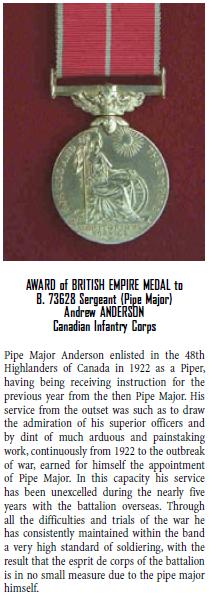

"Then, at the end of their stay in Italy, in march 1945, the 48th. was, as part
of 1st. Canadian Corps, transferred to the 1st.
Canadian Army in Holland by Operation Goldflake. The Regiment
travelled to Marseilles in LSTs. - split between 4 of them. The big
tank landing craft were running a shuttle service between Leghorn
and Marseilles to take the Canadians out of Italy."
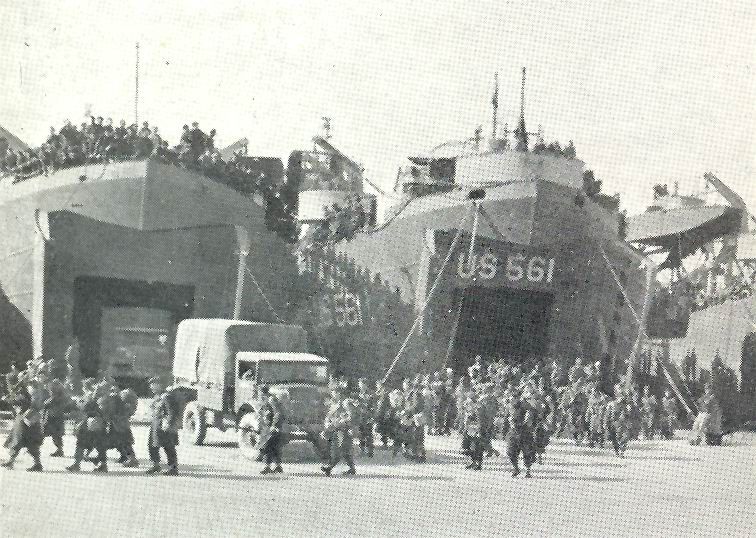

"It was now nine o'clock on March 13th, and they were nosing their
way through the sunken ships at the narrow mouth of Marseilles'
harbour. In Marseille harbour, the pipers playing them aboard their
TCVs.
The Highlanders moved toward Germany, through Turnhout, Uden and
Mook to battered billets in
Kranenburg. Next, the 48th Highlanders bedded down mid-way between
Deventer and Zutphen, surrounded by a concentration of the German
flying-bomb sites from which the devastating missiles had been
launched against England and the liberated coastal towns on this
side of the Channel.
The 1st
Division would go into its first action by crossing the Ijssel River
between Deventer and Zutphen, northeast of Arnhem. They would
jump-off on April 11th, and would break-out from the Ijssel
bridgehead westward, to capture Apeldoorn. This was Operation
Cannonshot. the 48th Highlanders' move across the Ijssel River had
been set for 5:00 A.M and that day Apeldoorn was liberated.
The 1st
Division would go into its first action by crossing the Ijssel River
between Deventer and Zutphen, northeast of Arnhem. They would
jump-off on April 11th, and would break-out from the Ijssel
bridgehead westward, to capture Apeldoorn. This was Operation
Cannonshot. the 48th Highlanders' move across the Ijssel River had
been set for 5:00 A.M and that day Apeldoorn was liberated."
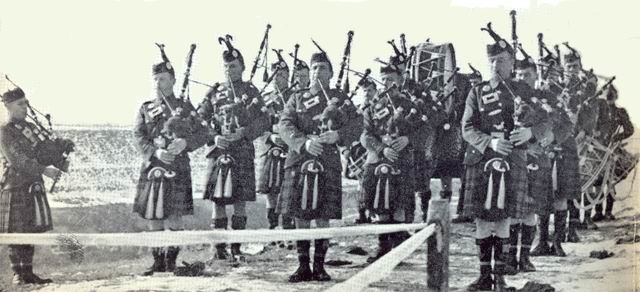
Afterward: Pipe major Anderson and band playing the Flowers of
the Forest at the temporary cemetery on the dyke at the Gorssel/Voorst river
crossing spot

"The victory celebration which the 48th Highlanders were still
ardently attending, had actually started the day they had stormed
over the Apeldoornsch Kanaal on April 17th to find the enemy had
fled. The private, squad, platoon and company parties, with girls,
rum punch, beer, the pipers or a dance band, now took on a faster
tempo."
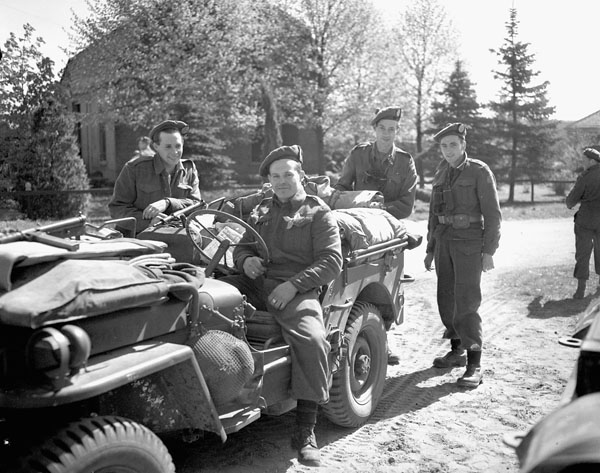
Captain Leadbeater of the 48th. Highlanders and his
jeep outside Apeldoorn, 1945

"They were then stationed at Stroe,until On May 8th; Holland's welcome to
the 48th Highlanders began all over again in a new scene,when they
moved to The Hague."
"They bypassed Amsterdam's traffic, but entire villages turned out to
cheer them, with flags everywhere, flowers tossed in front of their
rolling tires, and every honest Dutchman and his family adorned with
the royal orange, and standing beside the road to wave them through.
Delft turned out in such a cheering, hysterical mass that just short
of main force had to be applied to push a passage through the crush
for the Highlanders."
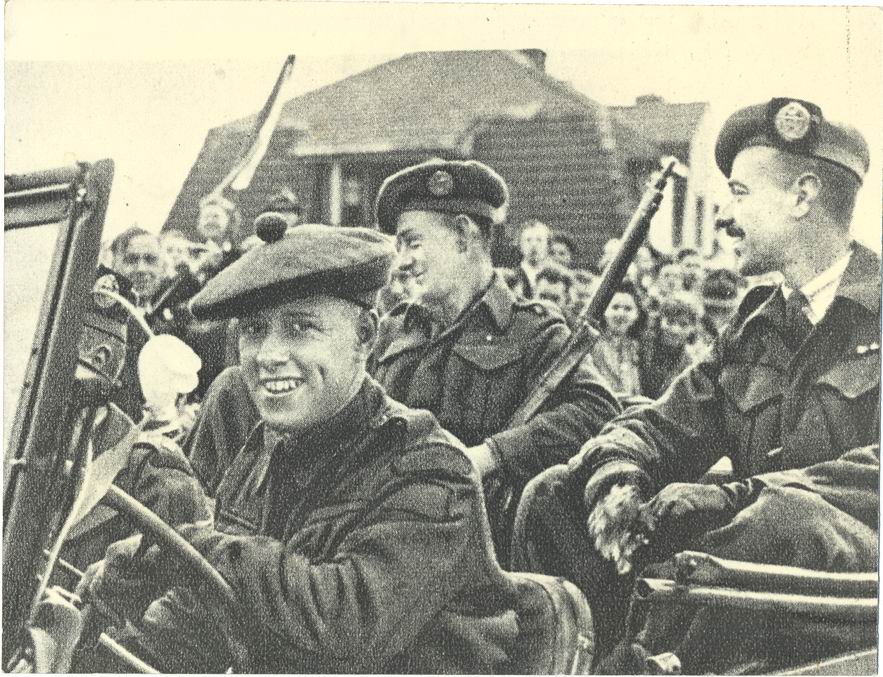
the same jeep and occupants, now driving past Delft
en route to
the Hague

"The 48th Highlanders were assigned to act as gaolers in The Hague to
Hitler's fanatical Nazis of the S.S. When the 48th Highlanders
entered The Hague on the morning of May 9th, all previous welcomes
proved mild demonstrations compared to this mobbing by hysterical
civilians. The crowds of cheering Dutch engulfed their TCV’s and
brought the 48th column to a dead stop."
"They disappeared into their billet, a large school, with a sense of
escape. It was at once besieged."
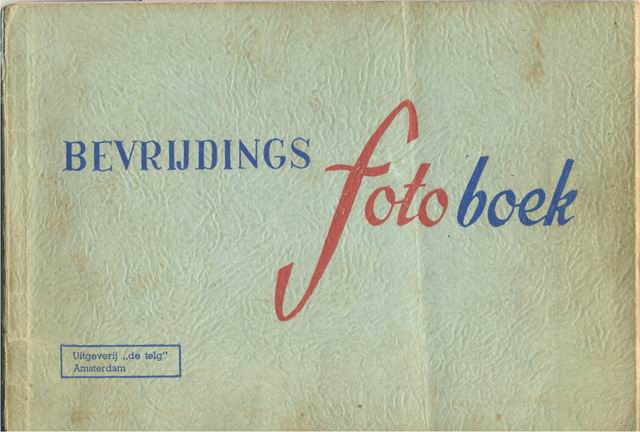
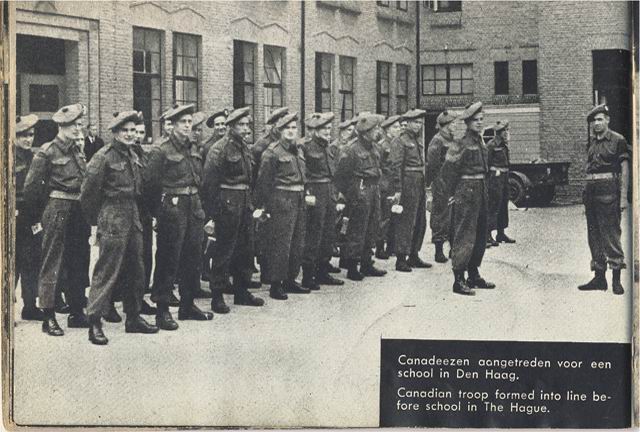
"Several Highlanders of Baker Company were missing for some hours;
they turned up later, each stoutly declaring, "Sir, I was kidnapped
by the Dutch," and only strained the truth slightly. The Pipe Band
played at several liberation parties through town."
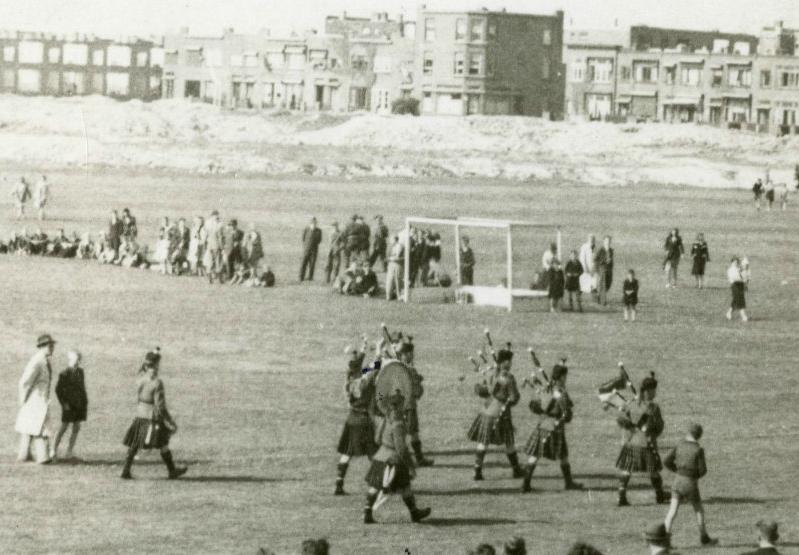
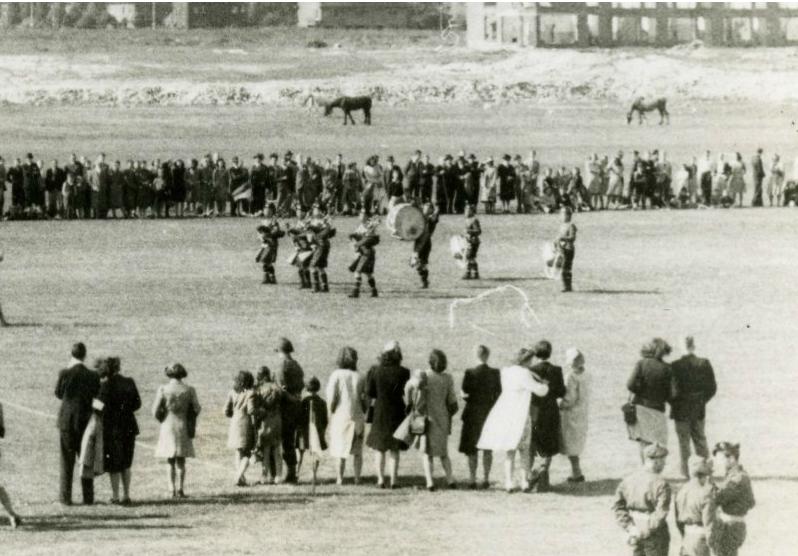
The band parading at the liberation festival on the
Sports Field "Stokroosveld". Note the bombed houses in the
background
"It was not all work and guard duty. The Highlanders had been
attending dances, seeing movies, and holding services in both St.
Anthony Abbot and St. Agnes churches."


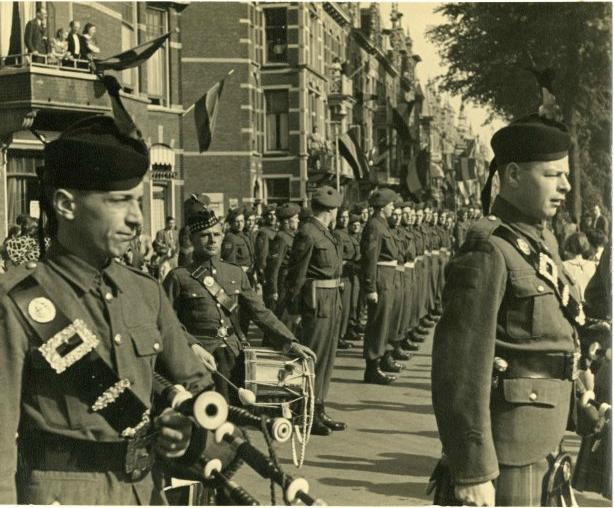
Church Parade at the
Regentessekerk

"Then came the gala event of their stay in The Hague. On Friday, May
18th, the citizens staged The Canadian Dutch Victory Ball, a
city-wide carousel under the guise of an all-night street dance."
"The Orderly Room bulletin board said "Bring your own drinking
utensil - beer and liquor will be on tap."
"Pipe-Major Anderson had gone back to Canada, and it was newly
promoted Pipe-Major Archie Dewar who gave the nod for Auch
Mountain's Bonny Glen and The Hills of Caithness. Then it was on
with the dance, launched by the Highland reel, Jock Wilson's Ball."

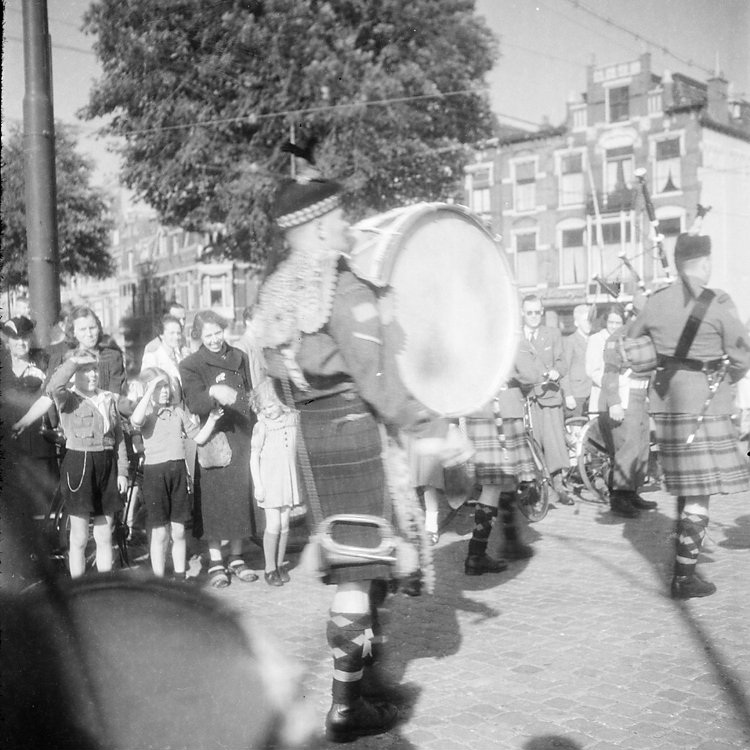
"It is a question who most enjoyed the carousel, the Dutch or the
Highlanders. The former, perhaps, because they had such greater
tolerance to vast quantities of Holland gin. Some of them were still
cavorting under drooping banners saying, "Welkom bevrijders!" when
the last Highlander surrendered and woozily sought his bed."
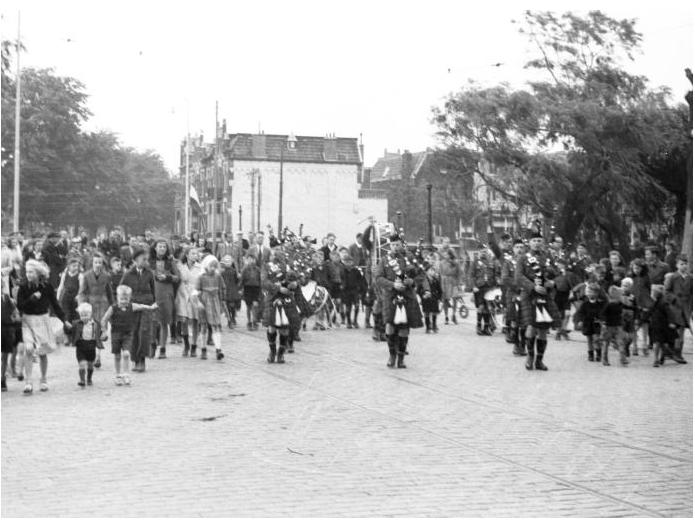
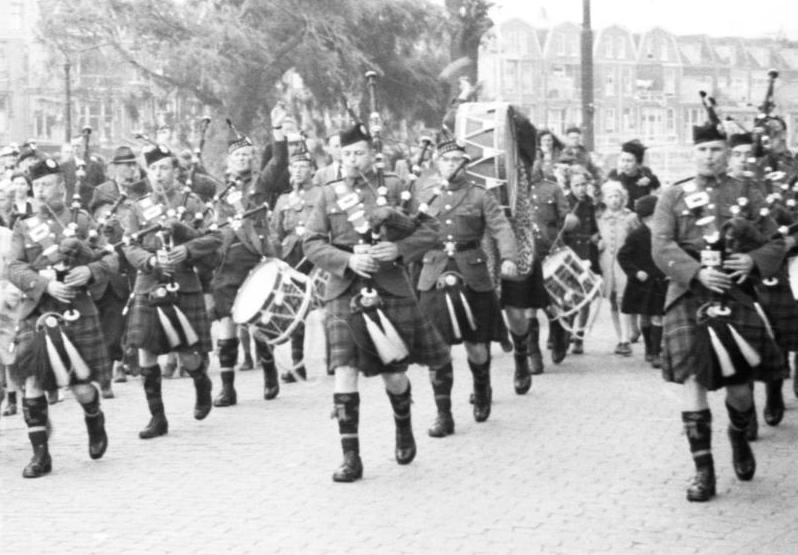
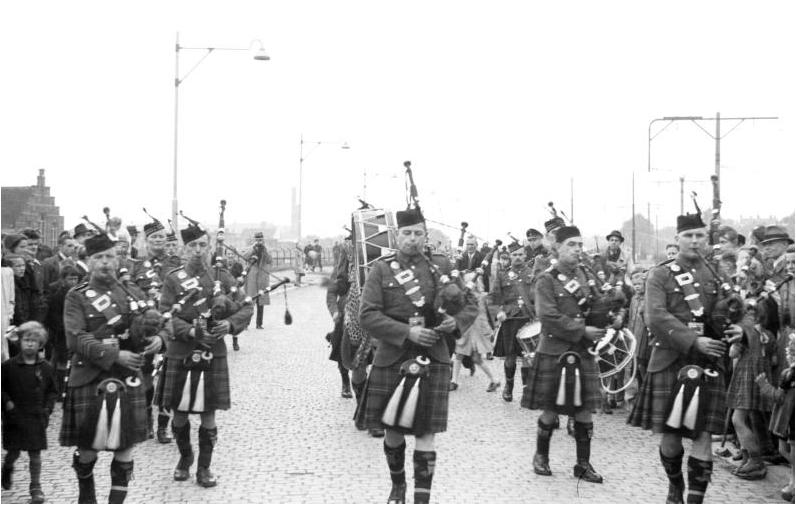
Archie Dewar shown on the left
here, sporting his Pipe Major's stripes since he had taken over from
Andy Anderson


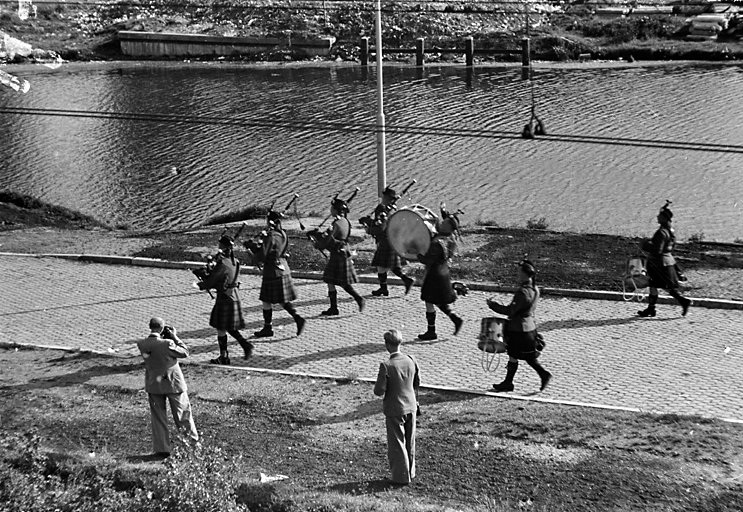
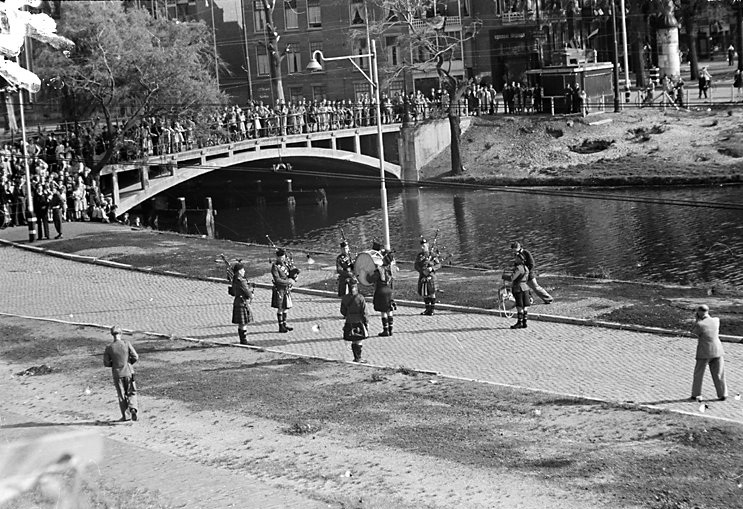
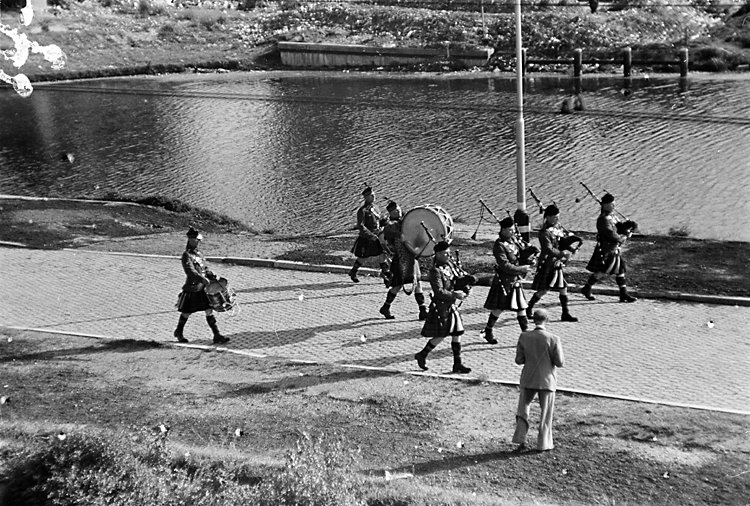
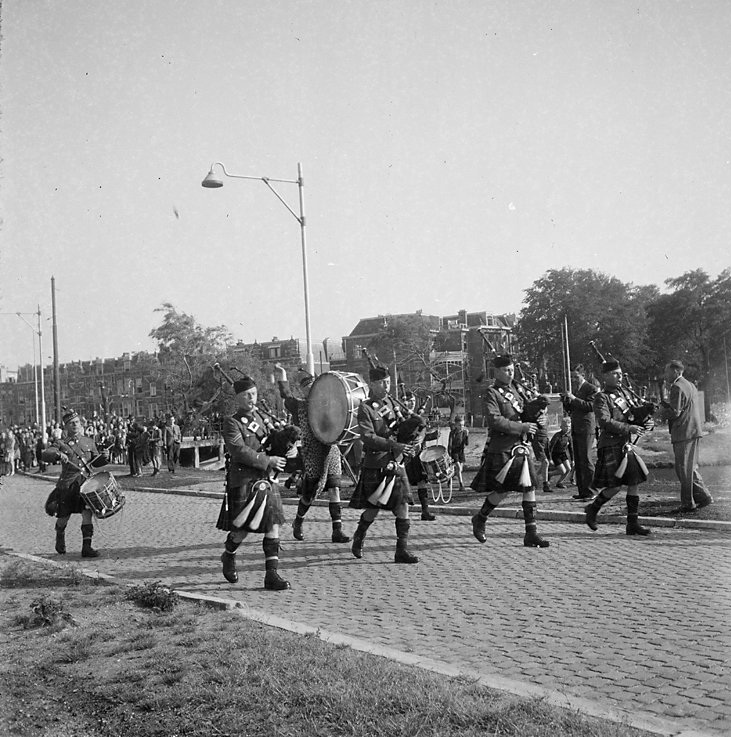
Band Practice without
Pipe Major Archibald Dewar present, along the
Suezkade in The Hague.


The Pipe Band also escorted the
Irene Brigade to a Memorial Service in the Grote Kerk, the Hague.
 Click here or on the
photograph above for a short clip of this event.
Click here or on the
photograph above for a short clip of this event.

"They left The Hague in mid-June for Soest, where they would wait,
and wait, after taking part in the Victory Parade at Rotterdam."

The 48th. walking past the
platform at the 1945 Rotterdam parade
"The Highlanders had not been pleased to depart from The Hague; after
they were rid of their unpleasant S.S. charges, they had begun to
enjoy the old city's cosmopolitan social life. At Soest, they knew
only a long monotony stretched ahead of them. They were housed in
the enemy's flying-bomb storage sheds instead of comfortable Dutch
homes."
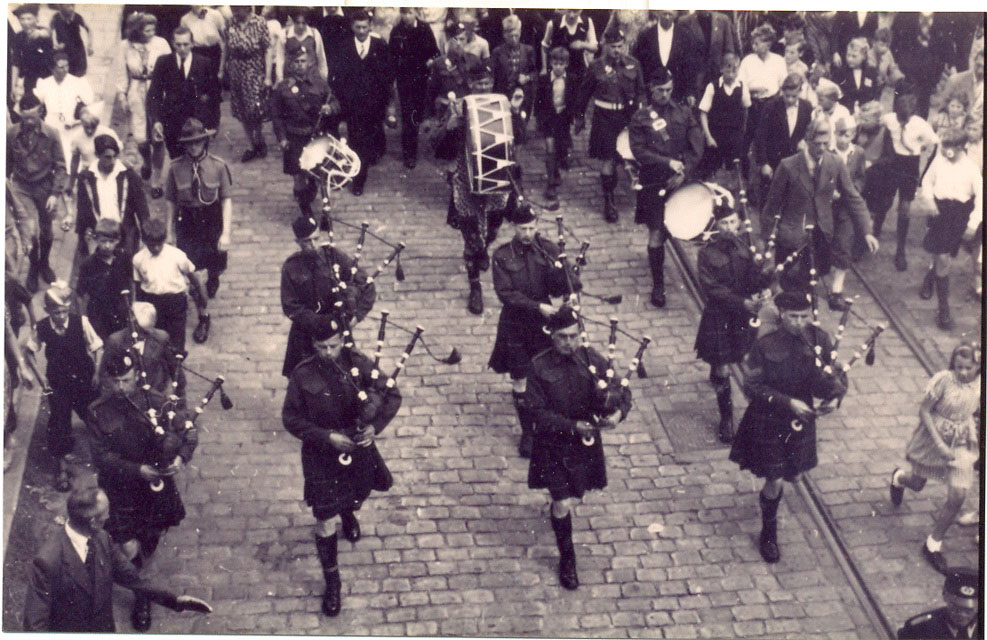
Here too, post-war Pipe Major Archibald Dewar is
shown leading the Pipe Band, on 20 April 1945, to play the Retreat
before Queen Wilhelmina's Palace at Apeldoorn

"The senior NCOs'. had long-service points, and could go home early.
The Pipe Band was hard hit; many had already gone home with Pipe-Major Andy
Anderson (who was awarded the B.E.M.) from Stroe or The Hague, and
by July 1st only 4 or 5 were left. The task of rebuilding fell upon
Archie Dewar and Bob Lindsay - now Pipe-Major and Pipe-Serjeant, and
the only pipers to go home with the Regiment who had left the Horse
Palace with them, or who had been even at Pachino."
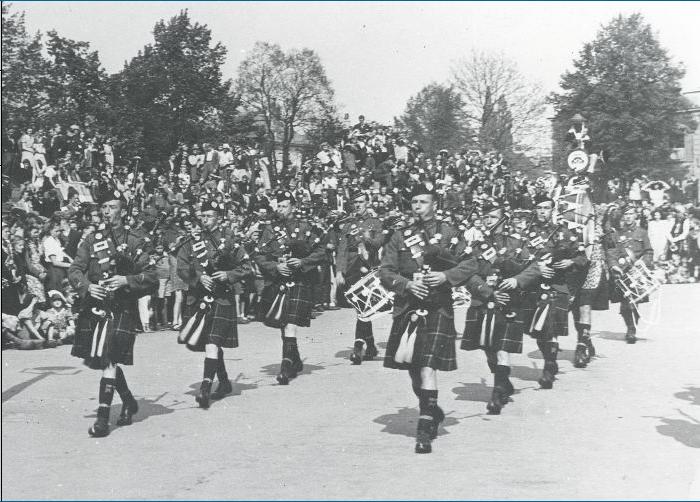
This concert was in Leeuwarden, June 1945, where even Pipe Major
Archibald Dewar was absent.
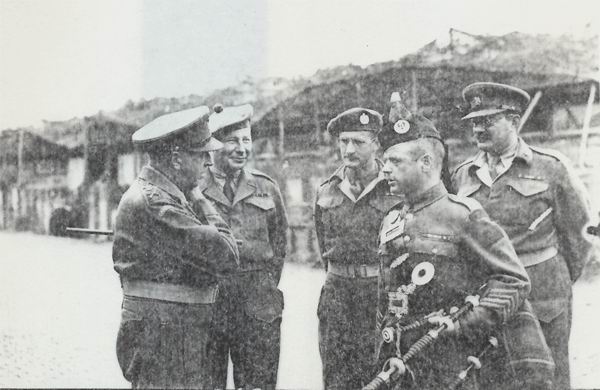
Because he had to attend the visit of
Crerar to the 1st. Division at Utrecht, 22 June 1945.

"August 30th. in Soest, the Pipe Band
played Retreat for the last time on the Continent of Europe. They
would leave in the morning, via England back to Canada."